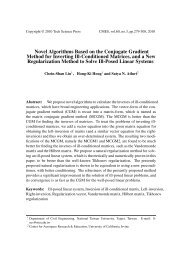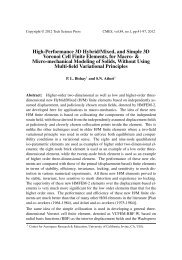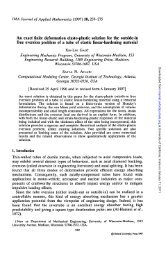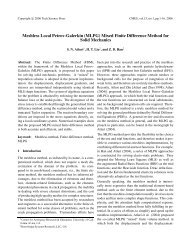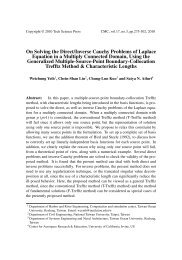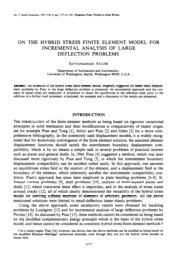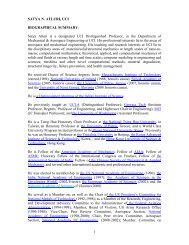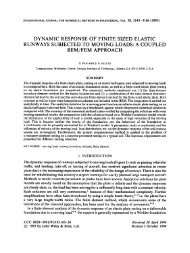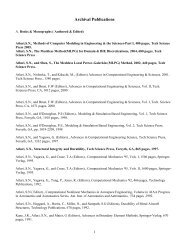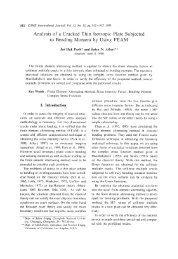Fig. 6. Comparison between the results of tests and EPFEAMfor P4consisting of a load and hold for twenty-four hours, unloadto zero load and hold for ®ve minutes, reload andhold for twenty-four hours, etc. <strong>The</strong> test lasted for aboutthirty days before failure. <strong>The</strong> ®ve-minute hold time wasenough time for signi®cant displacement recovery to occuralong with a signi®cant compressive zone to develop at thecrack tip. <strong>The</strong> alternating tension-compression-tensionconditions experienced near the crack tip are known tocause extensive creep damage near the crack tip (seeKrishnaswamy, Brust, and Ghadiali (1995), Brust andMajumdar (1994), Brust (1995a, 1995b)). Crack growthbegan on about the eighth day. <strong>The</strong> Murakami-Ohnoconstitutive law (see the cited References), which can accountfor the cyclic creep constitutive response, was used.<strong>The</strong> load versus crack growth record was input to the ®niteelement analysis. <strong>The</strong> applied maximum load was 23.353KN and plane stress was assumed.<strong>The</strong> predicted and experimental displacementsthroughout the entire 700 hours considered here areshown in Fig. 9. <strong>The</strong> analysis used the Murakami-Ohnoconstitutive law. Predictions using other constitutive lawstypically used for creep analyses (i.e., the Norton or strainhardeningcreep law) produce results signi®cantly lowerthan these. <strong>The</strong> upper curve represents the experimentaland predicted displacements at the end of the hold period,just before unloading, while the lower data points representthe displacements at the end of the hold period, justbefore unloading, while the lower data points represent the377Fig. 7. Comparison between the results of tests and EPFEAMfor P5Fig. 8. Comparison between the results of tests and EPFEAMfor P6Fig. 9a,b. Comparison of displacements for 9 Cr-Mo test: aMaximum displacements at the end of the reload-hold times.b Minimum displacements at the end of the unload-hold times
378displacements at the end of the unload hold period. <strong>The</strong>comparison is reasonable except beyond about 630 hours,where the predicted results begin to become large. <strong>The</strong>experiment began to experience unstable behavior at timesgreater than 700 hours.<strong>The</strong> dif®culty with using classical creep crack growthpredictive methods for these creep-fatigue problems is thatthese methods cannot account for the alternating tensileand compressive creep damage which develops at themoving crack tip. Even though the specimen is only unloadedto zero load, a large compressive creep zone emanatesfrom the crack tip as illustrated in Fig. 10. Figure 10illustrates the compressive stress zone that develops at theend of the unload hold periods at three different timesduring this test. (<strong>The</strong>se are analysis results). <strong>The</strong> classical(C ; C t ; etc.), which are based on asymptotic solutionsusing simplistic constitutive relations, cannot account forcyclic creep conditions.<strong>The</strong> T -integral was calculated throughout this entiretest. A plot of T versus time is illustrated in Fig. 11. T was evaluated on three different path sizes (R ˆ e here).Recall that unloading occurs at twenty four-hour incrementsthroughout this analysis Each time an unload/reloadoccurred, T remained at its' saturation value untilafter 600 Hours. After 600 Hours, T rises, i.e., failure ispredicted. Note that T achieving a constant valuethroughout the majority of the test shows that it is a validparameter since, during stable crack growth, only a givenFig. 10a-c. Compressive stress zones after unloading and holdingfor 0.1 hoursFig. 11. T -integral versus time for several de®nitions of path sizeamount of energy may be deposited at the growing cracktip. <strong>The</strong> rising T after 600 Hours indicates that the crackwas modeled as growing too slowly (recall that the input isexperimental crack growth versus time). What this meansis that, in an application phase analysis, after 600 Hours,T would predict more rapid crack growth than that observedexperimentally, i.e., T would predict earlier failurethat the experimental times.As indicated in Fig. 11, crack growth begins at 192hours, after the eighth unloading. Also note that the T integral attains a nearly constant value (close to the nucleationvalue) throughout the entire crack growth andtime history (between 100 and 130 KJ/m 2 , as indicated bythe lines in Fig. 11). This suggests that a constant value ofT will characterize crack growth under creep fatigueconditions. After about 628 hours the curves become unstable,suggesting that unstable creep failure is predicted.<strong>The</strong> nearly constant values for T during crack growthsuggests that this parameter may be used as a creep fractureparameter for cyclic creep. <strong>The</strong> fact that T is notperfectly uniform is due to three-dimensional crackgrowtheffects and the plane-stress assumption. However,these integrals may be used to predict crack initiation aswell as growth by using the value at initiation throughoutthe history. Many more details are illustrated in the citedpublications and will appear soon.6ConclusionsThis paper provided a review of the T -integral methodologyand the works that have been performed in recentyears which are attempting to validate its performance inpredicting the fracture response of cracked structureswhich experience severe conditions. T is valid undersimple load conditions as well (T equals J for instance formonotonic loading, stationary crack plasticity), and thusshould be viewed as a general parameter. <strong>The</strong> physicalbasis of T as an energetic parameter as well as practicalways to evaluate the method was reviewed here. Severalexample problems illustrating the practical use of themethod were summarized.<strong>The</strong> T -integral methodology discussed in this Part II ofthis report series will be used exclusively in Part III,




